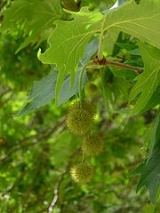
Platanus orientalis
Encyclopedia
Platanus orientalis, or the Oriental plane, is a large, deciduous tree
of the Platanaceae
family, known for its longevity and spreading crown. The species name derives from its historical distribution eastward from the Balkans
, where it was recognized in ancient Greek history and literature. Following Greek usage it is called Platane or related names in Europe
. It was equally as famous to the Iranian-speaking world and from Turkey
to India
is called Chinar, Chenar or related names, following the Iranian. The native range of the Oriental plane is Eurasia from the Balkans
to at least as far east as Iran
. Some accounts extend its native range to Iberia
in the west, and to the Himalaya in the east. As it has been known in cultivation from early times in much of this region, it can be difficult to determine if it is truly indigenous in peripheral areas.
, willow
and poplar
. However, it is quite capable of survival and success in dry soils once it is established.
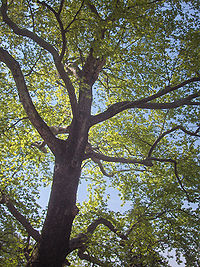 Like other plane trees
Like other plane trees
, its leaves are borne alternately on the stem, deeply lobed, and palmate or maple
-like. It usually has flaking bark, occasionally not flaking and becoming thick and rugged. Flowers and fruit are round and burr-like, borne in clusters of between 2 and 6 on a stem. Considerable variation exists among trees in the wild, and this may be complicated by crossbreeding with planted London plane
s (Platanus x hispanica), the hybrid of P. orientalis with the American sycamore
(Platanus occidentalis).
The tree is capable of being grown in most temperate latitudes, though it benefits greatly from warm summers. As a very large and wide tree with broad, thick leaves that tend to orient horizontally, it is especially prized for the shade and coolness it provides during the hot season.
The leaves and bark have been used medicinally. A fabric dye has been made from the twigs and roots. The timber
, often called lacewood, is figured and valuable for indoor furniture.
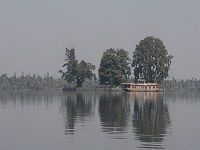
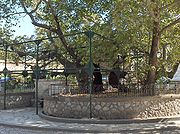 From earliest days, P. orientalis has been an important tree in Persian gardens, which are built around water and shade. There it is known as the chenar.
From earliest days, P. orientalis has been an important tree in Persian gardens, which are built around water and shade. There it is known as the chenar.
In historic Kashmir
, the tree was planted near Hindu holy places under names derived from the goddess Bhavani
. Later in Muslim times it continued to be a major garden and landscape tree and dominates many historic gardens, now generally called chinar. For example, a famous landmark in Srinagar
is an island on Dal Lake
where four chinar trees stand, named Char Chinar
. As another example, a 627-year-old chinar tree has been found at Chatargam, Chadoora, Badgam district
, Kashmir
. In repute it was planted in 1374 AD by an islamic mystic, Syed-Abul Qasim Shah Hamdani
.
Chinar trees are being felled rapidly in Kashmir, although a recent ban has been enacted to curb cutting. Chinar trees are now required to be registered and are considered National Property of the State. Registered Chinars are painted white at their base. Increased awareness means most old Chinars are protected and looked after; however, some new Chinars must be cut as their growth can cause damage to roads and houses. Most people now view the Chinar as a matter of national pride.
The Tree of Hippocrates
, under which Hippocrates
— the "Father of Medicine" — taught at Kos
, is reputed to have been an oriental plane. A 500-year-old tree presently there may be on the same site and may have been planted from a succession of cuttings from the original. The Athenian Academy, outside Athens, featured a sacred grove
of planes where the students listened to the masters and where among others the Peripatetics practiced philosophy.
Pliny
's Natural History records the westward progress of the plane "introduced among us from a foreign clime for nothing but its shade", planted first at the tomb of Diomedes on the island of Tremiti, then imported to Greek Sicily by Dionysius the Elder(c. 432-367 BC), tyrant of Syracuse. He had plane-trees conveyed to the city of Rhegium (Reggio di Calabria), where they were looked upon as the great marvel of his palace, according to Pliny's sources. From there it spread by the first century CE as far as the lands of the Morini
in Belgic Gaul. Regardless of why it may have been introduced, the tree had medicinal uses from early times. Pliny details 25 remedies using preparation from the bark, leaves and excrescences of plane. Some are still used: it stops bleeding and is used in eye ointment. Pliny prescribes it for burns, bites, stings, frost-bite and infections.
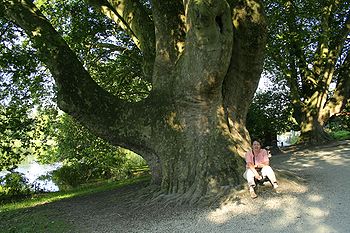 Pliny goes on to describe some legendary plane-trees. There was one on the grounds of the Athenian Academy, he says, that had roots 50 feet (15.2 m) long. Licinius Mucianus, legate of Lycia
Pliny goes on to describe some legendary plane-trees. There was one on the grounds of the Athenian Academy, he says, that had roots 50 feet (15.2 m) long. Licinius Mucianus, legate of Lycia
, held a banquet for 19 in a hollow plane-tree of Lycia, and the emperor Caligula
another for 15 plus servants in a tree house (nest) built in the branches of a plane-tree at Velletri
.
Most small villages in Greece have one or more very old planes in their central square, where the village water spring used to be (water springs are nowadays replaced by water taps from the same spring captured). Many of them are set in cavities, which are often playing and meeting points for children and teenagers, or are cared for, sometimes even illuminated, as tourist attractions.
In 2011 a specimen planted by Capability Brown
was identified as the tree with the greatest known spread in the United Kingdom.
During the 2010 Commonwealth Games opening ceremony
, the aerostat used took the shape of a chinar tree under the 'tree of knowledge' segment of the ceremony. This was followed by representation of different seasons through image projections and different dance styles being performed by hundreds of cultural dancers from all across India.
Tree
A tree is a perennial woody plant. It is most often defined as a woody plant that has many secondary branches supported clear of the ground on a single main stem or trunk with clear apical dominance. A minimum height specification at maturity is cited by some authors, varying from 3 m to...
of the Platanaceae
Platanaceae
Platanaceae is a family of flowering plants. It has been recognized by almost all taxonomists, and is sometimes called the "plane-tree family"....
family, known for its longevity and spreading crown. The species name derives from its historical distribution eastward from the Balkans
Balkans
The Balkans is a geopolitical and cultural region of southeastern Europe...
, where it was recognized in ancient Greek history and literature. Following Greek usage it is called Platane or related names in Europe
Europe
Europe is, by convention, one of the world's seven continents. Comprising the westernmost peninsula of Eurasia, Europe is generally 'divided' from Asia to its east by the watershed divides of the Ural and Caucasus Mountains, the Ural River, the Caspian and Black Seas, and the waterways connecting...
. It was equally as famous to the Iranian-speaking world and from Turkey
Turkey
Turkey , known officially as the Republic of Turkey , is a Eurasian country located in Western Asia and in East Thrace in Southeastern Europe...
to India
India
India , officially the Republic of India , is a country in South Asia. It is the seventh-largest country by geographical area, the second-most populous country with over 1.2 billion people, and the most populous democracy in the world...
is called Chinar, Chenar or related names, following the Iranian. The native range of the Oriental plane is Eurasia from the Balkans
Balkans
The Balkans is a geopolitical and cultural region of southeastern Europe...
to at least as far east as Iran
Iran
Iran , officially the Islamic Republic of Iran , is a country in Southern and Western Asia. The name "Iran" has been in use natively since the Sassanian era and came into use internationally in 1935, before which the country was known to the Western world as Persia...
. Some accounts extend its native range to Iberia
Iberian Peninsula
The Iberian Peninsula , sometimes called Iberia, is located in the extreme southwest of Europe and includes the modern-day sovereign states of Spain, Portugal and Andorra, as well as the British Overseas Territory of Gibraltar...
in the west, and to the Himalaya in the east. As it has been known in cultivation from early times in much of this region, it can be difficult to determine if it is truly indigenous in peripheral areas.
Description
The oriental plane is found naturally in riverine settings, together with such trees as alderAlder
Alder is the common name of a genus of flowering plants belonging to the birch family . The genus comprises about 30 species of monoecious trees and shrubs, few reaching large size, distributed throughout the North Temperate Zone and in the Americas along the Andes southwards to...
, willow
Willow
Willows, sallows, and osiers form the genus Salix, around 400 species of deciduous trees and shrubs, found primarily on moist soils in cold and temperate regions of the Northern Hemisphere...
and poplar
Poplar
Populus is a genus of 25–35 species of deciduous flowering plants in the family Salicaceae, native to most of the Northern Hemisphere. English names variously applied to different species include poplar , aspen, and cottonwood....
. However, it is quite capable of survival and success in dry soils once it is established.

Platanus
Platanus is a small genus of trees native to the Northern Hemisphere. They are the sole living members of the family Platanaceae....
, its leaves are borne alternately on the stem, deeply lobed, and palmate or maple
Maple
Acer is a genus of trees or shrubs commonly known as maple.Maples are variously classified in a family of their own, the Aceraceae, or together with the Hippocastanaceae included in the family Sapindaceae. Modern classifications, including the Angiosperm Phylogeny Group system, favour inclusion in...
-like. It usually has flaking bark, occasionally not flaking and becoming thick and rugged. Flowers and fruit are round and burr-like, borne in clusters of between 2 and 6 on a stem. Considerable variation exists among trees in the wild, and this may be complicated by crossbreeding with planted London plane
London Plane
Platanus × acerifolia, the London plane, London planetree, or hybrid plane, is a tree in the genus Platanus. It is usually thought to be a hybrid of Platanus orientalis and the Platanus occidentalis . Some authorities think that it may be a cultivar of P...
s (Platanus x hispanica), the hybrid of P. orientalis with the American sycamore
American sycamore
Platanus occidentalis, also known as American Sycamore, American plane, Occidental plane, and Buttonwood, is one of the species of Platanus native to North America...
(Platanus occidentalis).
The tree is capable of being grown in most temperate latitudes, though it benefits greatly from warm summers. As a very large and wide tree with broad, thick leaves that tend to orient horizontally, it is especially prized for the shade and coolness it provides during the hot season.
The leaves and bark have been used medicinally. A fabric dye has been made from the twigs and roots. The timber
Timber
Timber may refer to:* Timber, a term common in the United Kingdom and Australia for wood materials * Timber, Oregon, an unincorporated community in the U.S...
, often called lacewood, is figured and valuable for indoor furniture.
Cultural history


In historic Kashmir
Kashmir
Kashmir is the northwestern region of the Indian subcontinent. Until the mid-19th century, the term Kashmir geographically denoted only the valley between the Great Himalayas and the Pir Panjal mountain range...
, the tree was planted near Hindu holy places under names derived from the goddess Bhavani
Bhavani
Bhavani is a ferocious aspect of the Hindu goddess Parvati. Bhavani means "giver of life", the power of nature or the source of creative energy. In addition to her ferocious aspect, she is also known as Karunaswaroopini, "filled with mercy"....
. Later in Muslim times it continued to be a major garden and landscape tree and dominates many historic gardens, now generally called chinar. For example, a famous landmark in Srinagar
Srinagar
Srinagar is the summer seasonal capital of Jammu and Kashmir. It is situated in Kashmir Valley and lies on the banks of the Jhelum River, a tributary of the Indus. It is one of the largest cities in India not to have a Hindu majority. The city is famous for its gardens, lakes and houseboats...
is an island on Dal Lake
Dal Lake
Dal Lake is a lake in Srinagar, the summer capital of the northernmost Indian state of Jammu and Kashmir. The urban lake, which is the second largest in the state, is integral to tourism and recreation in Kashmir and is nicknamed the "Jewel in the crown of Kashmir" or "Srinagar's Jewel"...
where four chinar trees stand, named Char Chinar
Char Chinar
Char Chinar, also sometimes rendered Char Chinari, Ropa Lank, or Rupa Lank, is an island in Dal Lake, Srinagar, India. It is called as Char-Chinar because of the presence of four beautiful Chinar trees in this region. Chinar trees characteristically grow in Eastern Himalayas...
. As another example, a 627-year-old chinar tree has been found at Chatargam, Chadoora, Badgam district
Badgam district
Badgam is a district in the state of Jammu and Kashmir in India. Its headquarters is Badgam.-Demographics:According to the 2011 census Badgam district has a population of 735,753, roughly equal to the nation of Guyana or the US state of Alaska. This gives it a ranking of 494th in India . The...
, Kashmir
Kashmir
Kashmir is the northwestern region of the Indian subcontinent. Until the mid-19th century, the term Kashmir geographically denoted only the valley between the Great Himalayas and the Pir Panjal mountain range...
. In repute it was planted in 1374 AD by an islamic mystic, Syed-Abul Qasim Shah Hamdani
Mir Sayyid Ali Hamadani
Mir Syed Ali bin Shahab-ud-Din Hamadani was a Persian Sūfī of the Kubrāwī order, a poet and a prominent Muslim scholar. He was born on Monday, 12th Rajab 714 AH in Hamadan and died in 786 AH in Kunar and was buried in Khatlan...
.
Chinar trees are being felled rapidly in Kashmir, although a recent ban has been enacted to curb cutting. Chinar trees are now required to be registered and are considered National Property of the State. Registered Chinars are painted white at their base. Increased awareness means most old Chinars are protected and looked after; however, some new Chinars must be cut as their growth can cause damage to roads and houses. Most people now view the Chinar as a matter of national pride.
The Tree of Hippocrates
Tree of Hippocrates
The Tree of Hippocrates is the plane tree under which, according to the legend, Hippocrates of Kos taught his pupils the art of medicine. Paul of Tarsus purportedly taught here as well...
, under which Hippocrates
Hippocrates
Hippocrates of Cos or Hippokrates of Kos was an ancient Greek physician of the Age of Pericles , and is considered one of the most outstanding figures in the history of medicine...
— the "Father of Medicine" — taught at Kos
Kos
Kos or Cos is a Greek island in the south Sporades group of the Dodecanese, next to the Gulf of Gökova/Cos. It measures by , and is from the coast of Bodrum, Turkey and the ancient region of Caria. Administratively the island forms a separate municipality within the Kos peripheral unit, which is...
, is reputed to have been an oriental plane. A 500-year-old tree presently there may be on the same site and may have been planted from a succession of cuttings from the original. The Athenian Academy, outside Athens, featured a sacred grove
Sacred grove
A sacred grove is a grove of trees of special religious importance to a particular culture. Sacred groves were most prominent in the Ancient Near East and prehistoric Europe, but feature in various cultures throughout the world...
of planes where the students listened to the masters and where among others the Peripatetics practiced philosophy.
Pliny
Pliny the Elder
Gaius Plinius Secundus , better known as Pliny the Elder, was a Roman author, naturalist, and natural philosopher, as well as naval and army commander of the early Roman Empire, and personal friend of the emperor Vespasian...
's Natural History records the westward progress of the plane "introduced among us from a foreign clime for nothing but its shade", planted first at the tomb of Diomedes on the island of Tremiti, then imported to Greek Sicily by Dionysius the Elder(c. 432-367 BC), tyrant of Syracuse. He had plane-trees conveyed to the city of Rhegium (Reggio di Calabria), where they were looked upon as the great marvel of his palace, according to Pliny's sources. From there it spread by the first century CE as far as the lands of the Morini
Morini
The Morini were a Belgic tribe in the time of the Roman Empire. We know little about their language but one of their cities, Boulogne-sur-Mer was called Bononia by Zosimus and Bonen in the Middle Ages. Zosimus mentioned the Low Germanic character of the city...
in Belgic Gaul. Regardless of why it may have been introduced, the tree had medicinal uses from early times. Pliny details 25 remedies using preparation from the bark, leaves and excrescences of plane. Some are still used: it stops bleeding and is used in eye ointment. Pliny prescribes it for burns, bites, stings, frost-bite and infections.

Lycia
Lycia Lycian: Trm̃mis; ) was a region in Anatolia in what are now the provinces of Antalya and Muğla on the southern coast of Turkey. It was a federation of ancient cities in the region and later a province of the Roman Empire...
, held a banquet for 19 in a hollow plane-tree of Lycia, and the emperor Caligula
Caligula
Caligula , also known as Gaius, was Roman Emperor from 37 AD to 41 AD. Caligula was a member of the house of rulers conventionally known as the Julio-Claudian dynasty. Caligula's father Germanicus, the nephew and adopted son of Emperor Tiberius, was a very successful general and one of Rome's most...
another for 15 plus servants in a tree house (nest) built in the branches of a plane-tree at Velletri
Velletri
Velletri is an Italian town of 53,298 inhabitants. It is a comune in the province of Rome, on the Alban Hills, in Lazio - Italy. It is bounded by other communes of Rocca di Papa, Lariano, Cisterna di Latina, Artena, Aprilia, Nemi, Genzano di Roma, Lanuvio...
.
Most small villages in Greece have one or more very old planes in their central square, where the village water spring used to be (water springs are nowadays replaced by water taps from the same spring captured). Many of them are set in cavities, which are often playing and meeting points for children and teenagers, or are cared for, sometimes even illuminated, as tourist attractions.
In 2011 a specimen planted by Capability Brown
Capability Brown
Lancelot Brown , more commonly known as Capability Brown, was an English landscape architect. He is remembered as "the last of the great English eighteenth-century artists to be accorded his due", and "England's greatest gardener". He designed over 170 parks, many of which still endure...
was identified as the tree with the greatest known spread in the United Kingdom.
During the 2010 Commonwealth Games opening ceremony
2010 Commonwealth Games opening ceremony
The opening ceremony of the 2010 Commonwealth Games was held at the Jawaharlal Nehru Stadium, the main stadium of the event, in New Delhi, India...
, the aerostat used took the shape of a chinar tree under the 'tree of knowledge' segment of the ceremony. This was followed by representation of different seasons through image projections and different dance styles being performed by hundreds of cultural dancers from all across India.

